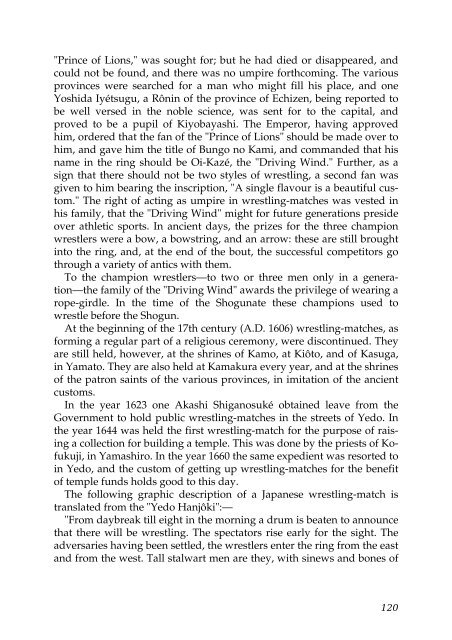Create successful ePaper yourself
Turn your PDF publications into a flip-book with our unique Google optimized e-Paper software.
"Prince <strong>of</strong> Lions," was sought for; but he had died or disappeared, and<br />
could not be found, and there was no umpire forthcoming. The various<br />
provinces were searched for a man who might fill his place, and one<br />
Yoshida Iyétsugu, a Rônin <strong>of</strong> the province <strong>of</strong> Echizen, being reported to<br />
be well versed in the noble science, was sent for to the capital, and<br />
proved to be a pupil <strong>of</strong> Kiyobayashi. The Emperor, having approved<br />
him, ordered that the fan <strong>of</strong> the "Prince <strong>of</strong> Lions" should be made over to<br />
him, and gave him the title <strong>of</strong> Bungo no Kami, and commanded that his<br />
name in the ring should be Oi-Kazé, the "Driving Wind." Further, as a<br />
sign that there should not be two styles <strong>of</strong> wrestling, a second fan was<br />
given to him bearing the inscription, "A single flavour is a beautiful custom."<br />
The right <strong>of</strong> acting as umpire in wrestling-matches was vested in<br />
his family, that the "Driving Wind" might for future generations preside<br />
over athletic sports. In ancient days, the prizes for the three champion<br />
wrestlers were a bow, a bowstring, and an arrow: these are still brought<br />
into the ring, and, at the end <strong>of</strong> the bout, the successful competitors go<br />
through a variety <strong>of</strong> antics with them.<br />
To the champion wrestlers—to two or three men only in a generation—the<br />
family <strong>of</strong> the "Driving Wind" awards the privilege <strong>of</strong> wearing a<br />
rope-girdle. In the time <strong>of</strong> the Shogunate these champions used to<br />
wrestle before the Shogun.<br />
At the beginning <strong>of</strong> the 17th century (A.D. 1606) wrestling-matches, as<br />
forming a regular part <strong>of</strong> a religious ceremony, were discontinued. They<br />
are still held, however, at the shrines <strong>of</strong> Kamo, at Kiôto, and <strong>of</strong> Kasuga,<br />
in Yamato. They are also held at Kamakura every year, and at the shrines<br />
<strong>of</strong> the patron saints <strong>of</strong> the various provinces, in imitation <strong>of</strong> the ancient<br />
customs.<br />
In the year 1623 one Akashi Shiganosuké obtained leave from the<br />
Government to hold public wrestling-matches in the streets <strong>of</strong> Yedo. In<br />
the year 1644 was held the first wrestling-match for the purpose <strong>of</strong> raising<br />
a collection for building a temple. This was done by the priests <strong>of</strong> K<strong>of</strong>ukuji,<br />
in Yamashiro. In the year 1660 the same expedient was resorted to<br />
in Yedo, and the custom <strong>of</strong> getting up wrestling-matches for the benefit<br />
<strong>of</strong> temple funds holds good to this day.<br />
The following graphic description <strong>of</strong> a <strong>Japan</strong>ese wrestling-match is<br />
translated from the "Yedo Hanjôki":—<br />
"From daybreak till eight in the morning a drum is beaten to announce<br />
that there will be wrestling. The spectators rise early for the sight. The<br />
adversaries having been settled, the wrestlers enter the ring from the east<br />
and from the west. Tall stalwart men are they, with sinews and bones <strong>of</strong><br />
120



